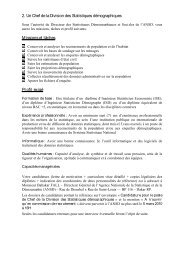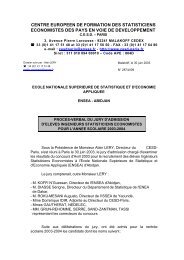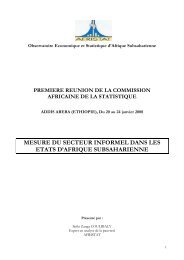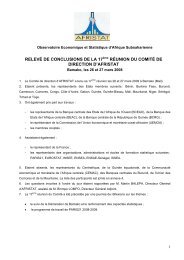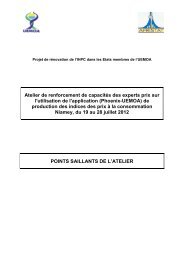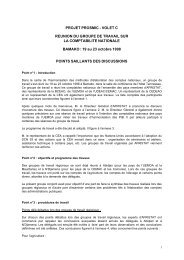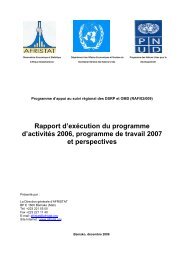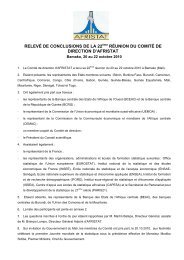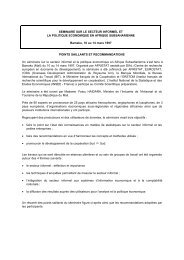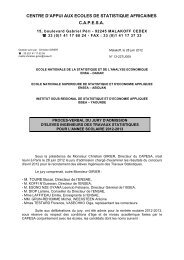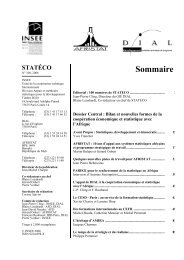Global Purchasing Power Parities and Real Expenditures - Afristat
Global Purchasing Power Parities and Real Expenditures - Afristat
Global Purchasing Power Parities and Real Expenditures - Afristat
Create successful ePaper yourself
Turn your PDF publications into a flip-book with our unique Google optimized e-Paper software.
AcknowledgmentsThe ICP shares a common technical language <strong>and</strong> conceptualframework with national statistical programs for measuringconsumer prices indexes (CPI) <strong>and</strong> their nationalaccounts. The very essence of the ICP is based on comparabilityof results between economies, strict adherenceto time schedules, <strong>and</strong> a common underst<strong>and</strong>ing of datasharing<strong>and</strong> confidentiality requirements. There is no otherstatistical program requiring so much cooperation betweennational, regional, <strong>and</strong> international organizations.The successful completion of ICP 2005 is a tribute tothe organizations <strong>and</strong> people who worked in partnership tocarry out the work program. The strength of the programcame from the division of the work program into five ICPregions that worked in parallel with the Eurostat-OECDPPP program so that all data could be combined into aset of global results. The technical <strong>and</strong> managerial leadershipfurnished by all in partnership sets the example forfuture international programs. Although the donors to theglobal trust fund have been noted, special thanks also goto the Canadian International Development Agency for itsfinancial support of the South America program, <strong>and</strong> to theArab Development Fund in its support of Western Asia.The recent contribution from the Islamic DevelopmentBank will form a strong basis for the program to move intothe next round. Each of the regional coordinating organizationsalso provided financial support, either in-kind, withfunds, or both.The 2005 ICP methodology was reengineered to overcomeprevious problems. The Technical Advisory Group(TAG) led by Alan Heston made significant contributions.The other TAG members were Angus Deaton, ErwinDiewert, Paul Konijn, Paul McCarthy, Prasada Rao, DavidRoberts, Sergey Sergeev, Silke Stapel, <strong>and</strong> Kim Zieschang.The global office of the ICP was located in the WorldBank’s Development Data Group (DECDG), led byShaida Badiee, Director, <strong>and</strong> Misha Belkindas, Manager.The ICP team responsible for the overall global coordination<strong>and</strong> technical support comprised Olga Akcadag, YonasBiru,Yuri Dikhanov, Nada Hamadeh, <strong>and</strong> Virginia Rom<strong>and</strong>.Recognition for their efforts is also given to former ICPteam members Giuliana Cane, Farah Hussain, Jinsook Lee,<strong>and</strong> Siew Hua Lee. Other members of DECDG providingvaluable support to the ICP included Azita Amjadi, LisaBurke, Sebastian Dessus, Olivier Dupriez, Ramgopal Erabelly,Richard Fix, Omar Hadi, Barbro Hexeberg, HuldaHunter, Soong Sup Lee, Vilas M<strong>and</strong>lekar, Changqing Sun,<strong>and</strong> Eric Swanson.The complexity of the program required input fromthis large group of technical experts who served as consultantsto the program: Sultan Ahmed, Derek Blades, StevenBurdette, Peter Hill, Anil Sawhney, <strong>and</strong> Kenneth Walsh.The overall leadership <strong>and</strong> policy making came fromthe ICP Executive Board, which included high-level leadershipfrom international, regional, <strong>and</strong> national statisticsxiii



